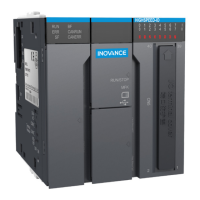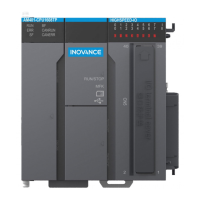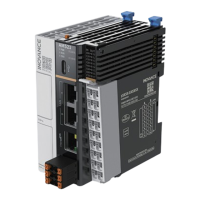-9-
Introduction
◆
An emergency stop circuit
,
protection circuit
,
forward/reverse operation interlocked circuit
,
and upper position
limit and lower position limit interlocked circuit must be set in the external circuits of the PLC to prevent damage
to the machine.
◆
To ensure safe operation
,
design external protection circuits and safety mechanisms for output signals that may
cause critical accidents.
◆
Once the PLC CPU detects a system abnormality
,
all outputs may be closed; however
,
when a fault occurs in the
controller circuit
,
the output may not be under control. Therefore
,
design an appropriate external control circuit
to ensure normal operation.
◆
If the PLC's output units such as the relay and transistor are damaged
,
the output may fail to switch between ON
and OFF state according to the commands.
◆
The PLC is designed to be used in indoor electrical environment (overvoltage category II). The power supply
must be equipped with a system-level lightning protection device to ensure that overvoltage caused by lightning
shock does not impact the power supply input terminal
,
signal input terminal
,
and control output terminal of
the PLC
,
avoiding damage to the equipment.
Installation
◆
Installation
,
wiring
,
maintenance
,
and inspection of the equipment must be carried out by professional
personnel who have received necessary training and master sucient electrical knowledge.
◆
Disconnect all external power supplies of the system before installing or uninstalling a module. Failure to comply
may result in electric shock
,
module fault
,
and malfunction.
◆
Do not use the PLC in places with dust
,
oil smoke
,
conductive dust
,
or corrosive or combustible gases
,
or expose
the PLC in environment of high temperature
,
condensation
,
wind and rain
,
vibration
,
or impact. Electric shock
,
re
,
and malfunction may also result in product damage or performance deterioration.
◆
The PLC is an open-type device. To protect operators without sucient knowledge about electrical devices
,
the
PLC must be installed in a control cabinet with a lock (the cabinet housing must provide protection of over IP20).
Only personnel who have received necessary training and master sucient electrical knowledge can open the
control cabinet.
◆
Prevent metal lings and wire ends from dropping into ventilation holes of the PLC during screw hole processing.
Failure to comply may result in re
,
fault
,
and malfunction.
◆
Ensure that no foreign matters are left on the ventilation surface after the PLC is installed. Failure to comply may
result in poor ventilation
,
causing re
,
fault
,
and malfunction.
◆
Ensure that the module is securely connected to the corresponding connector and hook the module rmly
during module installation. Improper installation may result in malfunction
,
fault
,
or fall-o of the module.
Wiring
◆
Installation
,
wiring
,
maintenance
,
and inspection must be carried out by professional personnel who have
received necessary training and master sucient electrical knowledge.
◆
Disconnect all external power supplies of the system before wiring. Failure to comply may result in electric
shock
,
device fault
,
and malfunction.
◆
After installation and wiring are complete
,
install the terminal covers delivered with the equipment before
powering on the PLC. Failure to comply may result in electric shock.
◆
Ensure good insulation for the cable terminals and keep the insulation distance between cables after connecting
cables to the terminal block. Failure to comply may result in electric shock and device damage.
◆
Use a proper protection device
,
which is usually a circuit breaker or external fuse capable of fusing and detection
,
for the input distribution circuit. Consider factors such as rated current and overload capability of the device and
the short-circuit capability of the power distribution in front of the device when selecting a protection part.

